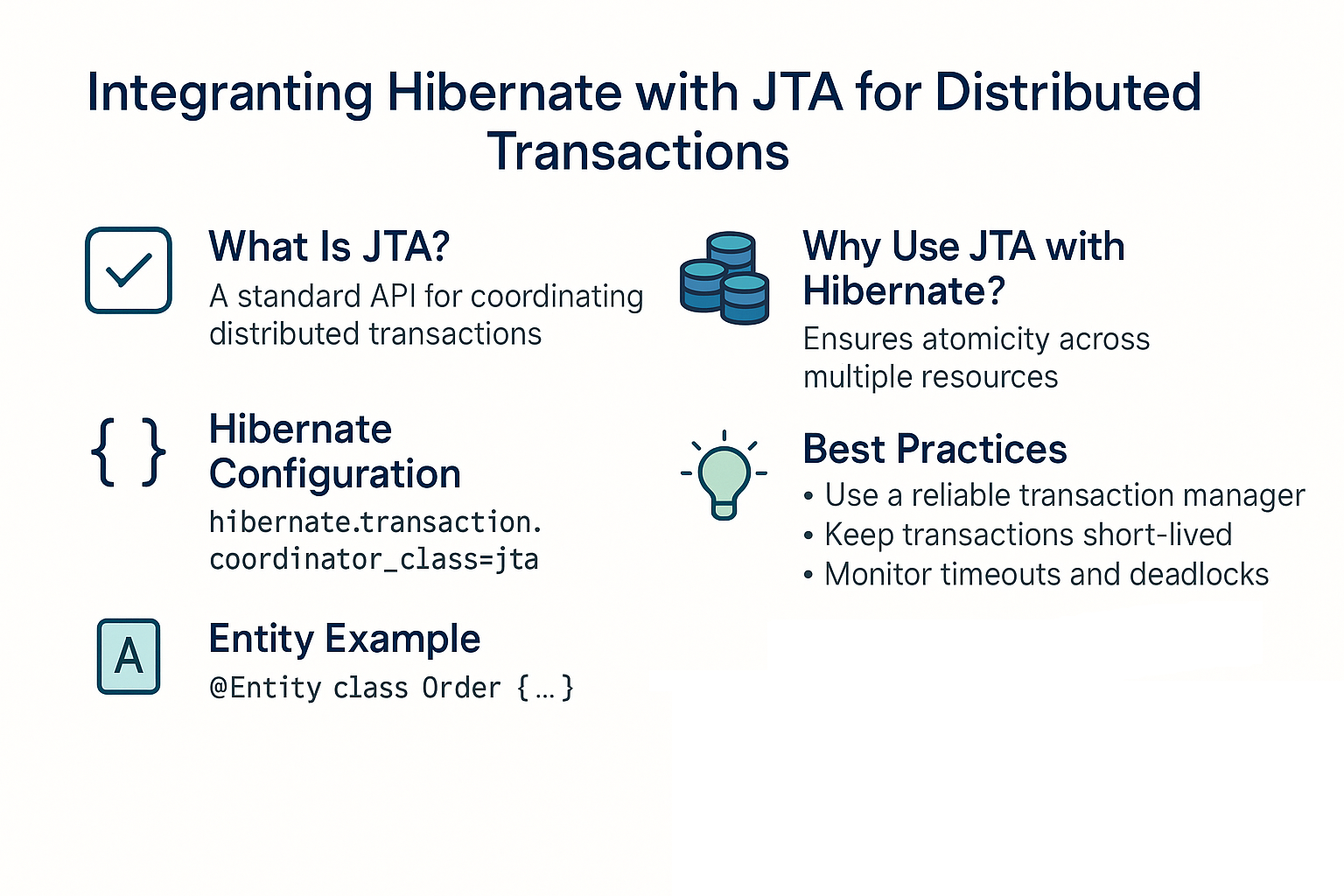Modern enterprise applications often need to perform transactions across multiple resources such as relational databases, message queues, or external systems. Ensuring consistency across these systems is critical. This is where JTA (Java Transaction API) comes into play.
Hibernate integrates seamlessly with JTA, enabling distributed transactions (also known as XA transactions) that guarantee ACID properties even across multiple resources.
Think of JTA as a traffic controller coordinating cars (transactions) across multiple intersections (resources) to ensure no collisions (data inconsistencies) happen.
In this tutorial, we’ll explore how Hibernate integrates with JTA, its configuration, and real-world best practices.
What is JTA in Hibernate?
JTA (Java Transaction API) is a standard API that allows Java applications to coordinate transactions across multiple resources. Hibernate, when configured with JTA, can participate in these distributed transactions.
Why JTA with Hibernate?
- Ensure atomicity across multiple databases.
- Integrate with messaging systems (e.g., JMS) in the same transaction.
- Use in enterprise Java platforms (Jakarta EE, Spring).
- Handle rollback consistently across all resources.
Hibernate with Local vs JTA Transactions
- Local Transactions: Hibernate manages a single JDBC connection.
- JTA Transactions: Hibernate participates in a global transaction managed by a transaction manager (e.g., Narayana, Atomikos, Bitronix).
Hibernate Configuration for JTA
Hibernate Properties
hibernate.transaction.coordinator_class=jta
hibernate.transaction.jta.platform=org.hibernate.engine.transaction.jta.platform.internal.JBossAppServerJtaPlatform
hibernate.current_session_context_class=jta
transaction.coordinator_class=jta: Enables JTA.jta.platform: Configures the transaction manager (e.g., JBoss, WebLogic, WebSphere, Atomikos).current_session_context_class=jta: Ensures Hibernate sessions bind to JTA transactions.
Example with Atomikos (Spring Boot)
spring:
jpa:
properties:
hibernate:
transaction:
coordinator_class: jta
jta:
platform: org.hibernate.engine.transaction.jta.platform.internal.AtomikosJtaPlatform
hibernate:
ddl-auto: update
Entity Example
@Entity
@Table(name = "orders")
public class Order {
@Id
@GeneratedValue(strategy = GenerationType.IDENTITY)
private Long id;
private String product;
private int quantity;
// getters and setters
}
Example: Distributed Transaction with Hibernate + JMS
Suppose we need to save an Order in the database and send a message to a JMS queue in the same transaction.
@Autowired
private EntityManager entityManager;
@Autowired
private JmsTemplate jmsTemplate;
@Transactional
public void processOrder(Order order) {
entityManager.persist(order);
jmsTemplate.convertAndSend("ordersQueue", order);
}
Here, both the database insert and JMS message are committed or rolled back together.
Hibernate Session and JTA
Hibernate binds the session lifecycle to JTA transactions.
session.joinTransaction()automatically joins the current JTA transaction.- No need to call
beginTransaction()explicitly.
Example
EntityManager em = entityManagerFactory.createEntityManager();
em.joinTransaction();
Order order = new Order();
order.setProduct("Laptop");
order.setQuantity(2);
em.persist(order);
Common Pitfalls & Anti-Patterns
- Using JTA for Simple Apps → Adds unnecessary complexity if only one DB is used.
- Long-Running Transactions → Increase lock contention and reduce scalability.
- Misconfigured Transaction Manager → Causes inconsistent commits/rollbacks.
- Mixing Local and JTA Transactions → Leads to unpredictable behavior.
Best Practices
- Use JTA only for multi-resource transactions.
- Keep distributed transactions short-lived.
- Always configure a reliable transaction manager (Atomikos, Narayana, Bitronix).
- Monitor for timeouts and deadlocks.
- In Spring Boot, prefer
@Transactionalfor declarative JTA management.
📌 Hibernate Version Notes
Hibernate 5.x
- Uses
javax.transactionpackage. - JTA integration via transaction platform classes.
- Supported in JBoss, WebLogic, WebSphere, Atomikos, Bitronix.
Hibernate 6.x
- Migrated to
jakarta.transaction. - Enhanced SQL support and query plan caching.
- Improved transaction handling and integration with Spring Boot 3.x.
- Cleaner JTA APIs for distributed systems.
Conclusion & Key Takeaways
- JTA allows Hibernate to participate in distributed, ACID-compliant transactions.
- Use it when working with multiple databases or external systems.
- Always configure the transaction manager correctly.
- Keep transactions short for better scalability.
- Hibernate + JTA = powerful integration for enterprise-grade systems.
FAQ: Expert-Level Questions
Q1: What’s the difference between Hibernate and JPA?
Hibernate is a JPA implementation that adds extended features like caching, batching, and JTA integration.
Q2: How does Hibernate caching improve performance?
By reducing database hits using first-level and second-level caching.
Q3: What are the drawbacks of eager fetching?
It loads unnecessary data upfront, causing memory and performance issues.
Q4: How do I solve the N+1 select problem in Hibernate?
Use fetch joins, @BatchSize, or entity graphs.
Q5: Can I use Hibernate without Spring?
Yes, Hibernate works standalone with JTA by configuring SessionFactory.
Q6: What’s the best strategy for inheritance mapping?
Depends: SINGLE_TABLE for performance, JOINED for normalization, TABLE_PER_CLASS for isolation.
Q7: How does Hibernate handle composite keys?
With @Embeddable and @EmbeddedId or @IdClass.
Q8: How is Hibernate 6 different from Hibernate 5?
Hibernate 6 adopts jakarta.transaction, with better SQL and query handling.
Q9: Is Hibernate suitable for microservices?
Yes, but microservices usually avoid XA transactions—prefer eventual consistency with messaging.
Q10: When should I not use Hibernate?
Avoid Hibernate with JTA if only one database is involved or when low-level SQL performance is critical.
